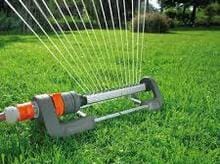irrigation system garden
A garden irrigation system refers to a method of providing crops and plants with water in a controlled and efficient manner. The purpose of this system is to deliver water directly to the plant roots to promote growth and avoid wastage. There are different types of irrigation systems including surface irrigation, sprinkler irrigation and drip irrigation. Each of these methods has its pros and cons, and choosing the right system depends on the specific needs of the garden.
Garden irrigation systems are used to supply water to plants and crops in a controlled and efficient manner. There are several types of garden irrigation systems, each with its own unique features and benefits. Here are the top garden irrigation systems, their uses, and a brief description:
Drip Irrigation System – This system delivers water directly to the roots of plants using a network of tubing and emitters. It is ideal for use in small gardens, raised beds, and in areas with water restrictions. Drip irrigation is highly efficient, as it reduces water wastage and promotes deep root growth.
Sprinkler Irrigation System – This system uses sprinklers that spray water over a wide area. It is best suited for larger gardens and lawns, as it covers a large area quickly. There are several types of sprinkler systems available, including rotary, impact, and misting sprinklers.
Micro-spray Irrigation System – This system delivers water to plants in a fine mist, making it ideal for use in greenhouse and nursery environments. It is also suitable for use in areas with low water pressure, as the fine mist helps to conserve water.
Flood Irrigation System – This system is a traditional method of irrigation that involves flooding fields with water. It is typically used in large-scale agriculture, and is most effective when used in flat or gently sloping fields.
Surface Irrigation System – This system uses channels or furrows to distribute water over the surface of a field or garden. It is best suited for use in large, flat fields and is typically used for crops that are not sensitive to water logging.
You have one bigger or less big field with plants or grass. At one time, this soil may want some water to fight with the sun. The solution is at the cloud with the rains, but also, you could try the irrigation system anytime.
SPRINKLERS:
Thus, for the smaller ground is good to choose a lawn sprinkler device or hose-end sprinkler system. A lawn sprinkler system can be permanently installed, as opposed to a hose-end

sprinkler, which is portable.
Sprinkler Under Ground systems are installed in residential lawns, in commercial landscapes, for churches and schools, in parks and golf lawns. These hose-end sprinklers can have various types of water-distribution functionality, such as oscillating, sweeping, pulsating, and arm whirling.
Sprinkler In-Ground systems, where watering heads are connected to an underground pipe system.
This type of system is highly automated – you’ll set up watering zones and schedule every to induce a specific quantity of water at a specific time. Variety of kinds of mechanical device heads are on the market for these mechanical device systems, permitting you to customize the water distribution counting on the sort of plants that are growing close to every head.
SOAKER HOSES
This is usually a really reasonable variety of watering systems. Generally, made from recycled tires, soaker hoses are riddled with little holes from that water seeps.You just hook them up to your spigot or to a leader hose that’s connected to the tap and switch on the water. Water drips along the entire length of the hose, meaning as it winds around your garden, even places where you don’t have plants. This is a potential downside.
DRIP IRRIGATION
Similar to a soaker hose, drip emitters contain an intact hose from that drip emitters (tubes with holes) extend. This enables for additional precise placement of the watering lengths. There are many different types of drip equipment, including drippers, bubblers, soakers (inline emitters), and micro-sprayers.
A serious advantage of soaker hoses and drip irrigation is that you’re putting the water at the base of plants, at ground level.
Each of these garden irrigation systems has its own advantages and disadvantages, and the best choice will depend on the size and type of garden you have, as well as your local water restrictions and regulations. When choosing a garden irrigation system, it is important to consider factors such as water efficiency, ease of installation, and maintenance requirements.
